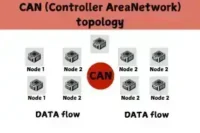Advantages and Disadvantages of Campus Area Network
Published: December 16, 2024
Managing multiple networks within a campus can be stressful, especially with poor connections and high maintenance costs. A Campus Area Network (CAN) helps by making everything easier to manage and more efficient. But it could be better. Let’s examine the advantages and disadvantages of CAN to see if it’s right for you.
A Campus Area Network (CAN) is a network that connects multiple Local Area Networks (LANs) within a limited area, such as a university, corporate campus, or industrial complex. It allows users in different buildings or locations within the campus to share resources, communicate, and access centralized systems efficiently.
Advantages and Disadvantages of Campus Area Network (CAN)
Let’s dive into the advantages and disadvantages of a CAN to see if it’s the right fit for you.
Advantages of Campus Area Network (CAN)
Understanding the pros of Campus Area Network (CAN) can help organizations optimize network performance while meeting users’ needs within a defined geographic area. These advantages of Campus Area Network make CANs an efficient and effective choice for educational institutions, businesses, and other organizations.
Here is a list of all the pros of Campus Area Network (CAN):
- Cost-Effectiveness
- Scalability
- Enhanced Security
- Centralized Management
- Improved Collaboration
- Simplified Network Design
- Efficient Resource Sharing
- Network Reliability
- Support for Mobile Devices
1. Cost-Effectiveness
Campus Area Networks (CANs) are cost-effective because they offer a more affordable alternative to larger networks like Wide Area Networks (WANs). They provide organizations with high-performance capabilities at a lower cost, especially regarding setup, maintenance, and operational expenses.

2. Scalability
CANs can easily grow with the needs of the organization. Whether adding new users, devices, or network resources, a CAN allows seamless expansion without major overhauls, making it adaptable to future requirements.
3. Enhanced Security
It can incorporate robust security protocols, such as encryption and firewalls, to protect sensitive data from unauthorized access and cyber threats. It also ensures the network keeps user information and organizational data safe and secure.
4. Centralized Management
A centralized management system enables network administrators to monitor, control, and manage the entire network from a single location. It simplifies updating, troubleshooting, and maintaining network security, making network management more efficient.
5. Improved Collaboration
By connecting users and departments across the campus, CANs facilitate easier communication and data sharing. It boosts team collaboration, enhancing teamwork, efficiency, and overall organizational productivity.

6. Simplified Network Design
It can have a simpler network structure compared to larger networks. This simplicity in design makes them easier to implement, manage, and maintain while still meeting the organization’s needs without unnecessary complexity.

7. Efficient Resource Sharing
It can enable sharing resources such as printers, servers, and storage devices across the campus. It helps optimize resource utilization, reduce costs, and improve operational efficiency by minimizing redundant hardware and software.
8. Network Reliability
It can ensure high reliability with built-in redundancy and failover mechanisms. These features ensure the network stays operational despite failure, providing consistent access and minimizing user downtime.
9. Support for Mobile Devices
CANs support many mobile devices, such as smartphones, laptops, and tablets. It allows users to stay connected and access network resources while moving around the campus, offering flexibility and improved mobility.
Disadvantages of Campus Area Network (CAN)
While offering several advantages, Campus Area Networks (CANs) also have challenges. These disadvantages of Campus Area Network can impact their efficiency, scalability, and overall performance.
Here is a list of all the cons of Campus Area Network (CAN):
- Limited Coverage Area
- High Initial Setup Costs
- Management and Scalability Challenges
- Security and Performance Risks
- Compatibility and Integration Issues
1. Limited Coverage Area
CANs are confined to a specific geographical area, limiting their reach. The physical infrastructure, such as cables, routers, and access points, also has limitations in terms of coverage, which can affect network access in remote or distant parts of the campus.
2. High Initial Setup Costs
The setup of a CAN can be expensive due to the costs associated with purchasing network hardware (e.g., routers, switches, cables) and installation. These initial expenses can be a significant investment, especially for smaller organizations or educational institutions
3. Management and Scalability Challenges
While CANs offer centralized management, this can become complex as the network grows. Scalability can be challenging because expanding a CAN requires upgrading infrastructure or adding new components, which can increase management complexity and costs.

4. Security and Performance Risks
CANs, like any network, are vulnerable to security breaches and cyber threats, such as hacking or data theft. These security risks can also affect network performance, as attacks like Distributed Denial of Service (DDoS) can overwhelm network resources, slowing down or disrupting services.
5. Compatibility and Integration Issues
CANs may face compatibility issues when integrating with existing systems or devices, especially older hardware or software. It can cause inefficiencies and, in some cases, may require additional investments in upgrades or replacements to ensure smooth integration.
Conclusion
A Campus Area Network (CAN) is an efficient solution for connecting multiple Local Area Networks (LANs) within a defined campus, such as a university, business, or industrial complex. By centralizing management and enabling resource sharing, CANs significantly improve collaboration, scalability, and network reliability. The Advantages and Disadvantages of Campus Area Network (CAN) highlight its potential to optimize performance and reduce operational costs while offering enhanced security and support for mobile devices.
However, organizations must also carefully consider the advantages and disadvantages of Campus Area Network (CAN). While CANs provide cost-effectiveness and streamlined network design, they come with challenges such as limited coverage area, high initial setup costs, and potential scalability and compatibility issues. Despite these limitations, a well-planned CAN can be a powerful and valuable networking solution for organizations seeking to improve connectivity, communication, and efficiency within a defined geographic area.
FAQS about Advantages and Disadvantages of Campus Area Network (CAN)
A Campus Area Network (CAN) is a network that connects multiple Local Area Networks (LANs) within a limited area, such as a university, corporate campus, or industrial complex, enabling resource sharing and efficient communication.
The main advantages of a CAN include:
Cost-effectiveness, Scalability, Enhanced Security, Centralized Management, Improved Collaboration, Simplified Network Design, Efficient Resource Sharing, Network Reliability, Support for Mobile Devices.
A CAN reduces costs by centralizing resources (like printers, servers, and storage), minimizing redundant hardware and maintenance expenses, and offering high performance at a lower operational cost than larger networks.
Some challenges of CANs include:
Limited Coverage Area, High Initial Setup Costs, Management and Scalability Challenges, Security and Performance Risks, Compatibility and Integration Issues.
A CAN is typically confined to a specific geographical area, such as a university campus, corporate office, or industrial zone. It does not extend beyond these boundaries.
A CAN allows efficient sharing of resources like printers, servers, and internet connections across multiple buildings. It minimizes redundancy, optimizes resource usage, and reduces operational costs.
It can incorporate robust security measures such as encryption, firewalls, and centralized control to protect sensitive data from unauthorized access and cyber threats.
Yes, CANs support mobile devices like smartphones, laptops, and tablets, allowing users to stay connected and access network resources while moving around the campus.
As the network grows, expanding a CAN can become complex and costly. Adding new infrastructure or upgrading components may require careful planning and increased management efforts.
CANs may experience integration challenges when working with older hardware or software, which can cause inefficiencies. In such cases, additional investments may be needed for upgrades to ensure smooth compatibility.
Encryption converts sensitive data into unreadable code, making it difficult for unauthorized users to access or tamper with. Even if hackers intercept encrypted data, they cannot decipher it without the decryption key.





